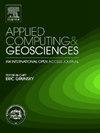利用环境协变量和机器学习方法估算美国德克萨斯州下布拉索斯河流域的地上生物量
IF 3.2
Q2 COMPUTER SCIENCE, INTERDISCIPLINARY APPLICATIONS
引用次数: 0
摘要
森林生态系统在全球固碳中发挥着关键作用,是减缓气候变化的基本碳汇,同时还提供一系列生态系统服务,如种子传播、授粉、虫害防治和栖息地供应。本研究旨在利用全球生态系统动态调查光探测和测距(GEDI-LiDAR)的环境协变量和机器学习方法估计美国德克萨斯州下布拉索斯河流域的地上生物量密度(AGBD)。具体来说,来自美国国家航空航天局(NASA)橡树岭国家实验室分布式主动档案中心(ORNL DAAC)的GEDI 4A级数据与Landsat-9作战陆地图像(OLI)和航天飞机雷达地形任务(SRTM)数据集成,以提高AGBD的预测精度。利用Landsat 9反演的归一化植被指数(NDVI)和增强植被指数(EVI)等光谱指数支持AGBD预测。部署了三种机器学习模型,如多元自适应样条回归(MARS)、随机森林(RF)和极端梯度增强(XGBoost),并使用决定系数(R2)、均方根误差(RMSE)和平均绝对误差(MAE)来评估性能。其中,XGBoost的预测准确率最高(R2 = 0.43, RMSE = 31.03, MAE = 22.49)。模拟结果表明,经度、纬度、水分应力指数(MSI)和数字高程模型(DEM)是AGBD的重要预测因子。整个流域的平均AGBD估计为72.3 Mg ha-1,相当于总生物量约为6660万吨。常绿森林的AGBD值最高,为110 Mg ha-1,而耕地平均为33 Mg ha-1。这些发现强调了将环境协变量与机器学习相结合,以估计GEDI激光雷达在不同生态系统中的AGBD的有效性。这一方法为推进碳管理和减缓气候变化工作提供了强有力的工具,同时也支持以数据为导向的森林和农业景观保护规划。本文章由计算机程序翻译,如有差异,请以英文原文为准。
Estimating aboveground biomass using environmental covariates and a machine-learning approach in the Lower Brazos River Basin, Texas, USA
Forest ecosystems play a pivotal role in global carbon sequestration, serving as essential carbon sinks for climate change mitigation, while also providing a range of ecosystem services such as seed dispersal, pollination, pest control, and habitat provisioning. This study aimed to estimate aboveground biomass density (AGBD) using environmental covariates and a machine learning approach from the Global Ecosystem Dynamics Investigation Light Detection And Ranging (GEDI-LiDAR) in the Lower Brazos River Watershed, Texas, USA. Specifically, GEDI Level 4A data from the National Aeronautics and Space Administration (NASA) Oak Ridge National Laboratory Distributed Active Archive Center (ORNL DAAC) was integrated with Landsat-9 Operational Land Imagery (OLI) and Shuttle Radar Topographic Mission (SRTM) data to enhance predictive accuracy for AGBD. Spectral indices, including the Normalized Difference Vegetation Index (NDVI) and Enhanced Vegetation Index (EVI), were derived from Landsat 9 to support AGBD prediction. Three machine learning models, such as Multivariate Adaptive Regression Splines (MARS), Random Forest (RF), and eXtreme Gradient Boosting (XGBoost), were deployed, with performance assessed using the coefficient of determination (R2), root mean square error (RMSE), and mean absolute error (MAE). Among the models, XGBoost achieved the highest predictive accuracy (R2 = 0.43, RMSE = 31.03, MAE = 22.49). The modelling indicated that longitude, latitude, moisture stress indices (MSI), and digital elevation model (DEM) are among the critical predictors for AGBD. The mean AGBD across the watershed was estimated at 72.3 Mg ha-1, corresponding to a total biomass of approximately 66.6 million tons. Evergreen forests showed the highest AGBD values at 110 Mg ha-1, while cultivated lands averaged 33 Mg ha-1. These findings highlight the effectiveness of integrating environmental covariates with machine learning to estimate AGBD from GEDI LiDAR across diverse ecosystems. This approach provides a robust tool for advancing carbon management and climate change mitigation efforts, while also supporting data-driven conservation planning in both forested and agricultural landscapes.
求助全文
通过发布文献求助,成功后即可免费获取论文全文。
去求助
来源期刊

Applied Computing and Geosciences
Computer Science-General Computer Science
CiteScore
5.50
自引率
0.00%
发文量
23
审稿时长
5 weeks
 求助内容:
求助内容: 应助结果提醒方式:
应助结果提醒方式:


